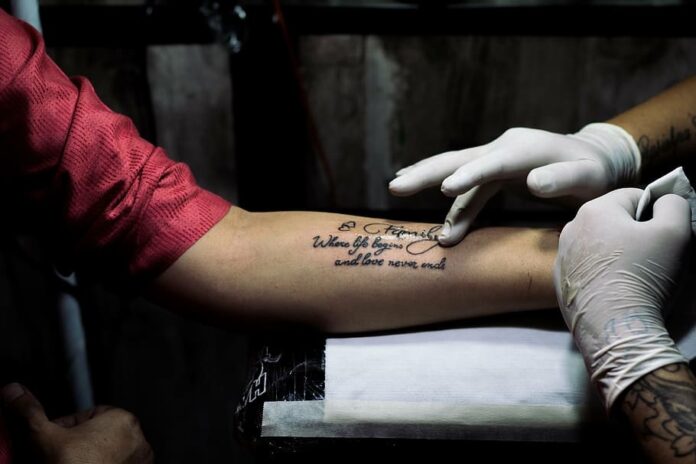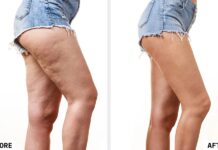Tattoos have become a popular form of self-expression and art, with millions of people getting inked every year. While tattoos can be a beautiful and meaningful addition to one’s body, they require proper care and maintenance to ensure they heal correctly. One of the most common questions people have about tattoos is whether blood can ruin a fresh tattoo.
When getting a tattoo, it is normal to experience some bleeding. However, excessive bleeding can cause the ink to become diluted, resulting in a patchy or faded tattoo. In addition, if the equipment used to create the tattoo is contaminated with infected blood, it can lead to various bloodborne diseases, including hepatitis B and C, and MRSA. Therefore, it is essential to take proper precautions to prevent excessive bleeding and ensure the equipment used is sterile.
Proper aftercare is crucial for the healing process of a tattoo. Neglecting to care for a new tattoo can lead to infection, scarring, and even the need for touch-up work. It is essential to follow the instructions provided by the tattoo artist, which typically include keeping the tattoo clean and dry for a certain period, avoiding exposure to direct sunlight, and refraining from scratching or picking at the tattoo.
Key Takeaways
- Proper aftercare is crucial for the healing process of a tattoo.
- Excessive bleeding can cause the ink to become diluted, resulting in a patchy or faded tattoo.
- Contaminated equipment used to create a tattoo can lead to various bloodborne diseases.
The Impact of Blood on a Fresh Tattoo
When getting a tattoo, it is common to experience some bleeding during the process. However, excessive bleeding can negatively impact the final outcome of the tattoo. Blood can ruin a fresh tattoo if not handled properly, leading to a distorted or faded design.
If a person experiences excessive bleeding during the tattooing process, it can cause the ink to spread, leading to blurred lines and an overall distorted design. Additionally, if blood is not properly wiped away, it can mix with the ink and cause the colors to appear faded or dull.
It is crucial to follow proper aftercare instructions to prevent blood from ruining a fresh tattoo. After the tattoo is complete, the artist will clean the area and apply a bandage or wrap to protect it. It is important to keep the tattoo clean and dry, avoiding any activities that may cause excessive sweating or rubbing against the tattoo. If the bandage becomes soaked with blood, it should be changed immediately to prevent the blood from mixing with the ink.
If a person experiences bleeding after the tattoo is complete, it is important to address it promptly. Excessive bleeding can cause the ink to be pushed out of the skin, leading to a faded design. Applying pressure to the area and elevating the tattoo can help to reduce bleeding.
In summary, blood can ruin a fresh tattoo if not handled properly. Excessive bleeding during the tattooing process can cause the ink to spread, leading to a distorted design. Proper aftercare is crucial to prevent blood from mixing with the ink and causing the colors to appear faded or dull. If a person experiences bleeding after the tattoo is complete, it is important to address it promptly to prevent the ink from being pushed out of the skin.
How to Care for a New Tattoo
Getting a new tattoo is exciting, but it’s important to take proper care of it to ensure that it heals properly. Here are some tips to help you care for your new tattoo:
1. Leave the covering on for a few hours
After getting a tattoo, your artist will cover it with a bandage or plastic wrap to protect it from dirt and bacteria. It’s important to leave this covering on for a few hours or as directed by your tattoo artist. This will help prevent infection and allow the tattoo to properly heal.
2. Wash the tattoo gently
Once you remove the covering, gently wash the tattoo with a mild soap and lukewarm water. Avoid using hot water, as it can irritate the tattoo. Use your hands to gently wash the tattoo, and avoid using a washcloth or anything abrasive.
3. Apply an ointment or lotion
After washing the tattoo, apply a thin layer of ointment or lotion to keep it moisturized. Your tattoo artist may recommend a specific product, but any fragrance-free, gentle lotion or ointment will do. Apply the lotion or ointment several times a day, but don’t overdo it.
4. Avoid picking or scratching the tattoo
While your tattoo is healing, it’s important to avoid picking or scratching it. This can cause the ink to come out, and it can also lead to infection. If your tattoo starts to itch, gently pat it with a clean, damp cloth.
5. Protect the tattoo from the sun
After your tattoo has healed, it’s important to protect it from the sun. UV rays can fade the ink and cause it to blur over time. Always apply sunscreen to your tattoo before going outside, and avoid tanning beds and prolonged sun exposure.
By following these tips, you can help ensure that your new tattoo heals properly and looks great for years to come.
Potential Risks of Blood on a Tattoo
When getting a tattoo, it’s not uncommon for a little bit of blood to be present. However, if the bleeding is excessive, it can cause problems for the tattoo and the person getting it. Here are some potential risks of blood on a tattoo:
Infection
If the equipment used to create the tattoo is contaminated with infected blood, it can lead to various bloodborne diseases, including hepatitis B, hepatitis C, and methicillin-resistant Staphylococcus aureus (MRSA) [1]. Infection can also occur if the person getting the tattoo has an open wound or if the artist doesn’t follow proper hygiene protocols.
Ruined Tattoo
Blood on a tattoo can also ruin the artwork. If the blood is left on the tattoo for too long, it can cause the ink to blur or fade, making the tattoo look less sharp and defined. Additionally, if the blood dries on the tattoo, it can cause scabbing, which can pull off the ink and leave blank spots [2].
Keloid Scarring
Keloid scarring is another risk associated with blood on a tattoo. Keloids are raised, thickened areas of skin that form at the site of an injury. They can occur when the body produces too much scar tissue in response to an injury, such as a cut or burn. Tattoos have the potential to scar, especially if they don’t heal properly or if the person has an allergic reaction [3]. Blood on a tattoo can increase the likelihood of keloid scarring.
It’s essential to take proper care of a tattoo to prevent these risks. After getting a tattoo, it’s important to keep the area clean and dry and follow the aftercare instructions provided by the artist. If there is excessive bleeding or signs of infection, it’s crucial to seek medical attention immediately.
Preventing Excessive Bleeding During Tattooing
When getting a tattoo, it is normal to experience some bleeding. However, excessive bleeding can ruin a tattoo and make it difficult to achieve the desired results. Therefore, it is important to take steps to prevent excessive bleeding during tattooing.
One of the most important steps to prevent excessive bleeding is to ensure that the tattoo artist is using a clean and sterile environment. This means that the artist should use fresh needles and disposable gloves for each client. Additionally, the artist should use a clean and sterile work surface and equipment.
Another important step to prevent excessive bleeding is to ensure that the client is well hydrated before the tattoo session. This can help to keep the blood flowing smoothly and prevent excessive bleeding. Additionally, the client should avoid alcohol and blood-thinning medications before the tattoo session, as these can increase the risk of bleeding.
During the tattoo session, the artist should work in small sections and allow time for the blood to clot before moving on to the next section. This can help to prevent excessive bleeding and ensure that the tattoo is applied evenly. Additionally, the artist should use a light touch and avoid overworking the skin, as this can also increase the risk of bleeding.
Finally, after the tattoo session, the client should follow the artist’s aftercare instructions carefully to promote healing and prevent bleeding. This may include keeping the tattoo clean and dry, avoiding tight clothing that can rub against the tattoo, and avoiding activities that can cause excessive sweating or friction.
By taking these steps to prevent excessive bleeding, clients can ensure that their tattoos look great and heal properly.
Professional Guidance on Tattoo Aftercare
After getting a tattoo, it is essential to take care of it properly to ensure it heals well and looks great. Here are some tips from tattoo artists and dermatologists on how to care for your tattoo after getting inked:
Keep the Area Clean
According to board-certified dermatologist Dr. Marie Leger, keeping the area clean is crucial in preventing infection. She recommends washing the tattoo gently with mild soap and water twice a day and patting it dry with a clean towel. Avoid using abrasive materials or rubbing the tattoo too hard, as this can damage the skin and cause scabbing.
Apply Moisturizer
After washing the tattoo, it is essential to apply a moisturizer to keep the skin hydrated and prevent itching. Tattoo artist Anka Lavriv recommends using a fragrance-free lotion or ointment, such as Aquaphor or A&D ointment, to avoid irritation. Apply a thin layer of moisturizer to the tattooed area, but avoid using too much, as this can clog pores and slow down the healing process.
Avoid Sun Exposure
Sun exposure can cause the tattoo to fade and damage the skin, so it is crucial to protect the area from the sun’s harmful rays. Board-certified dermatologist Dr. Robert Finney recommends applying sunscreen with an SPF of at least 30 to the tattooed area whenever you go outside. He also suggests avoiding tanning beds and sunlamps, as these can also fade the ink and increase the risk of skin cancer.
Don’t Pick or Scratch
It can be tempting to scratch or pick at a healing tattoo, but this can damage the skin and cause scarring. Tattoo artist Anka Lavriv advises against touching the tattoo with dirty hands or picking at any scabs that may form. Instead, let the tattoo heal naturally and avoid wearing tight clothing that may rub against the tattooed area.
Follow Up with Your Tattoo Artist
If you have any concerns or questions about your healing tattoo, don’t hesitate to contact your tattoo artist. They can provide you with additional aftercare instructions and advice on how to care for your tattoo properly. They may also recommend coming in for a follow-up appointment to ensure the tattoo is healing well and to touch up any areas that may need it.
By following these aftercare tips, you can help ensure your tattoo heals well and looks great for years to come.
Conclusion
In conclusion, it is essential to take proper care of a new tattoo to avoid any complications. Blood can ruin a tattoo if it is not cleaned properly, leading to infections and other health risks. It is crucial to follow the aftercare instructions provided by the tattoo artist to ensure that the tattoo heals correctly.
If there is excess blood on the tattoo, it should be cleaned gently with a damp cloth. However, it is essential not to rub the tattoo as it can cause damage to the skin. It is also essential to avoid picking at scabs as it can lead to scarring and ruin the tattoo.
It is recommended to avoid swimming, soaking in a bathtub, or exposing the tattoo to direct sunlight for at least two weeks after getting a new tattoo. It is also essential to avoid wearing tight clothing or anything that can rub against the tattoo.
If there are any signs of infection, such as redness, swelling, or pus, it is essential to seek medical attention immediately. Bloodborne diseases can also be a risk if the equipment used to create the tattoo is not properly sterilized. It is crucial to choose a reputable tattoo artist who uses sterile equipment to minimize the risk of infection.
Overall, taking proper care of a new tattoo is crucial to ensure that it heals correctly and looks great for years to come.
Frequently Asked Questions
How can I prevent bleeding from ruining my tattoo?
Bleeding during the tattooing process is normal, but excessive bleeding can affect the quality of the tattoo. To prevent this, it is important to follow the aftercare instructions provided by your tattoo artist. Keep the tattoo clean and dry, avoid tight clothing that can rub against the tattoo, and avoid activities that can cause excessive sweating or irritation. It is also important to avoid picking or scratching the tattoo, as this can cause bleeding and damage the healing skin.
What should I do if my tattoo is bleeding after a week?
If your tattoo is bleeding after a week, it is important to seek medical attention immediately. This could be a sign of an infection or other serious complication. In the meantime, keep the tattoo clean and dry, and avoid any activities that can cause further irritation or bleeding.
Is it safe to leave a tattoo bandage on for too long?
Leaving a tattoo bandage on for too long can cause the skin to become moist and create an ideal environment for bacteria to grow. It is recommended to remove the bandage after 2-4 hours and clean the tattoo with mild soap and water. After cleaning, apply a thin layer of ointment or lotion and keep the tattoo exposed to air.
How long should I keep my tattoo wrapped in cling film?
Cling film should only be used for a short period of time after getting a tattoo. It can help protect the tattoo from outside contaminants, but it can also trap moisture and bacteria against the skin. It is recommended to remove the cling film after 2-4 hours and follow the aftercare instructions provided by your tattoo artist.
What’s the best way to clean blood off of a healing tattoo?
To clean blood off of a healing tattoo, gently wash the area with mild soap and water. Do not use hot water or abrasive materials, as this can cause further irritation or damage to the healing skin. Pat the area dry with a clean towel and avoid rubbing or scratching the tattoo.
Can physical trauma, like being slapped, ruin a new tattoo?
Physical trauma, such as being slapped, can cause damage to a new tattoo and affect the healing process. It is important to avoid any activities that can cause trauma to the tattoo, including excessive rubbing, scratching, or exposure to sunlight. If you experience any pain or discomfort, seek medical attention immediately.







